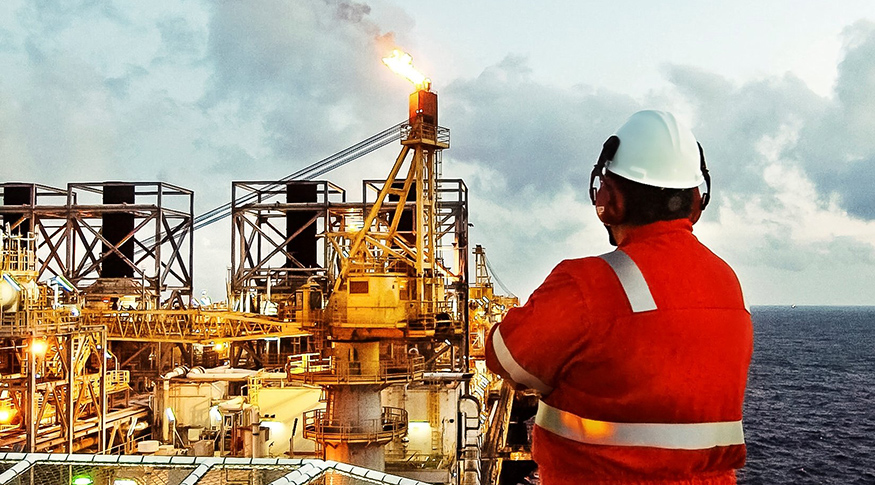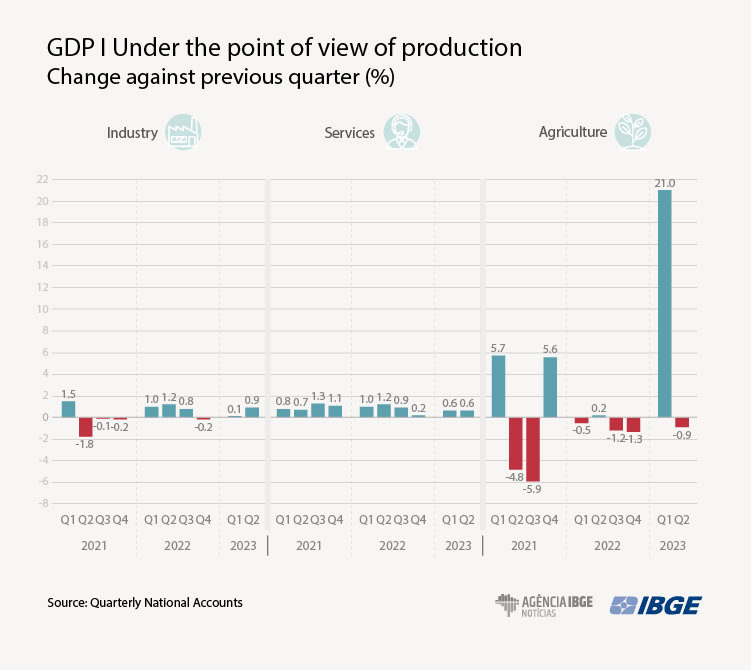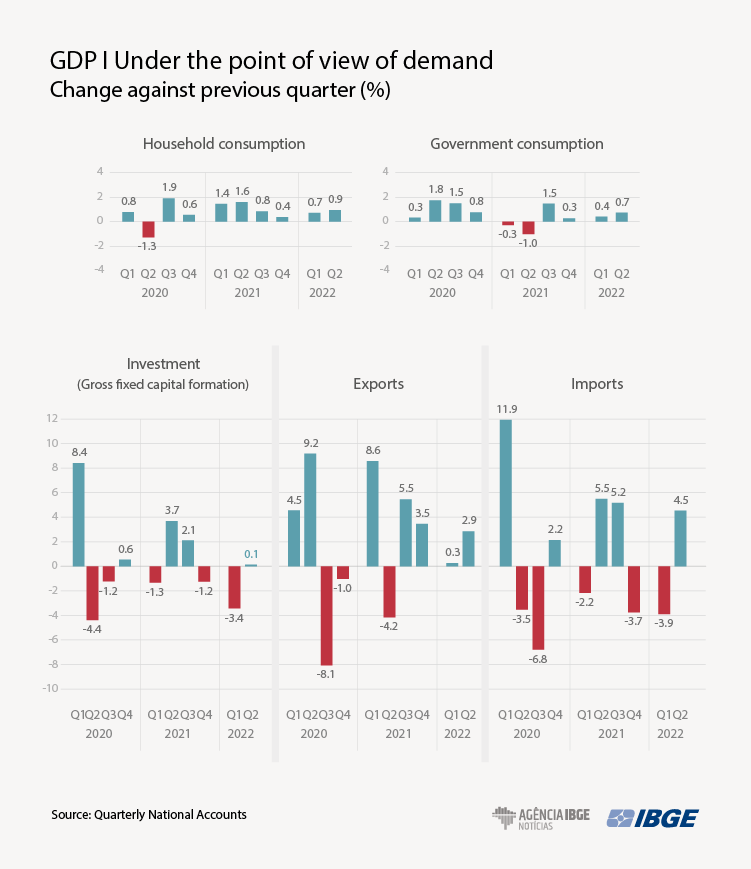National Accounts
GDP grows 0.9% in second quarter, closes semester with rise of 3.7%
September 01, 2023 09h00 AM | Last Updated: September 01, 2023 05h06 PM

Between the first and second quarters this year, the Gross Domestic Product (GDP) grew 0.9%, the eighth consecutive positive result of the indicator in this comparison. The result is lower than that registered in the first quarter (1.8%). The GDP, which is the sum of the final goods and services produced in Brazil, added up to R$2.651 trillion in current values in the quarter ended in June.
With this result, it advanced 3.7% in the first semester of the year. In this scenario, the Brazilian economic activity works 7.4% above the pre-pandemic level, related to the fourth quarter of 2019, and hits the peak in the time series. The second highest level is that of the previous quarter. The data are from the System of Quarterly National Accounts, released today (1) by the IBGE.

The rise in the second quarter is explained by the good performance of industry (0.9%) and services (0.6%). As the services activities account for nearly 70% of the Brazilian economy, the result of this sector influences even more the expansion of the GDP.
“Financial services leveraged this result within the services sector, especially insurance, like life insurance, car insurance, real estate insurance and financial risk insurance. Other services like those relative to enterprises, like legal and accounting services, also stood out,” explains Rebeca Palis, the IBGE´s Coordinator of National Accounts. The services sector does not record any negative change for 12 quarters and it is in the peak of its time series.
The industrial activities stood on the positive side for the second quarter in a row, after changing -0.2% in the last three months last year. The expansion in the second quarter is related to the positive results of mining and quarrying industries (1.8%), construction (0.7%), electricity and gas, water, sewerage and waste management (0.4%) and manufacturing industries (0.3%).
In mining and quarrying industries, the highlight is petroleum and gas extraction and iron extraction, products related to exports. The change in the second quarter is the fifth consecutive positive change of the mining and quarrying sector. Industry as a whole remains above the pre-pandemic level, though it did not manage to surpass the peak of its time series, hit in the third quarter of 2013.
Agriculture was the only one of the three major sectors of the economy to retreat in the quarter (-0.9%). The retraction comes after the advance of 21.0% in the first quarter and it is mainly due to a high comparison basis. “If we look at the inter-annual indicator, agriculture is the activity that mostly grows. The result is lower because it is compared with the previous quarter, which registered a significant increase. It happened because 60% of the production of soybeans is concentrated in the first quarter,” analyzes Palis. With the decrease of the weight of this crop in the second quarter, the share of other products increases, like coffee, which grows less than the major agricultural product in Brazil.

Household consumption grows 0.9% in quarter
Household consumption advanced 0.9% in the second quarter. It is the highest rise since the same period a year ago (1.6%). “On the positive side, the labor market has been constantly improving, credit is growing, as well as several governmental measures like tax incentives causing the reduction in the prices of cars, and adjustments in cash transfer programs, especially the Bolsa Família. On the other hand, interests remain high, which hampers the consumption of durable goods, and families remain indebted as they take time to recover, in spite of the debt renegotiation program,” says her.
Also in relation to the previous quarter, government consumption grew 0.7%, the fourth positive result in a row. Concerning investments (Gross fixed capital formation), the scenario was of stability (0.1%). The investment rate was 17.2% of the GDP, below that of the same period in 2022 (18.3%). This indicator represents the parcel of investments in the overall production of final goods and services in Brazil. According to the coordinator of National Accounts, the result is due to the drop in the domestic production of capital goods, the so-called items used to manufacture other products for more than one period, like machinery and equipment.
In the same period, the savings rate also dropped: it changed from 18.4% in the second quarter last year to 16.9% in the same period this year. “This result was expected and it happens since the first quarter. It increased during the pandemic, as higher-income families saved the excess money as they could not consume certain services. With the regularization of the demand and supply of services, the savings rate dropped,” explains her.
In the foreign sector, both exports of goods and services (2.9%) and imports (4.5%) grew over the first quarter this year.

GDP grows 3.4% over the same period in 2022; agriculture grows 17.9%
The GDP grew 3.4% against the second quarter last year. In this same comparison, agriculture grew 17.0%, the best result among the sectors. This rise is related to the good performance of some products like soybeans, corn, cotton and coffee. The livestock estimates contributed with this result as well.
On the other hand, industry grew 1.5%, highlighted by mining and quarrying industries (8.8%), which benefited from the increase in the extraction of petroleum and gas, and of ferrous minerals. In the activity of electricity and gas, water, sewerage and waste management (4.8%), the impact came from the residential consumption of energy, favored by the improvement in the tariff flags.
In the same comparison, services advanced 2.3%. Among the sectors that stood out, financial activities, insurance and related services (6.9%) was influenced by the good performance of insurance.
GDP advances 3.7% in the first semester
In the first semester, the GDP grew 3.7%. The three major sectors grew in the period: agriculture (17.9%), industry (1.7%) and services (2.6%). “The agricultural sector stood out in the semester, due to an excellent result caused by record harvests of soybeans and corn,” explains the researcher.
Among the industrial activities, the highlights were mining and quarrying industries (8.2%), electricity and gas, water, sewerage and waste management (5.6%) and construction (0.9%). Manufacturing industries (-1.3%) dropped in the same period.
In services, the sectors that grew were: financial activities, insurance and related services (5.8%), information and communication (5.3%), transportation, storage and mailing (4.2%), other services activities (3.3%), real estate activities (2.8%), administration, defense, public health and education, and social security (1.0%) and trade (0.9%).
About the System of National Accounts
The System of National Accounts shows the current values and the volume indexes, on a quarterly basis, for the Gross Domestic Product (GDP) at market prices, net taxes on products, value added at basic prices, personal consumption, government consumption, gross fixed capital formation, stock change, exports and imports of goods and services. The survey began in 1988 at the IBGE and it was restructured in 1998, when their results were integrated to the System of National Accounts, of annual periodicity. The next release of the Quarterly National Accounts is scheduled to December 5.


















